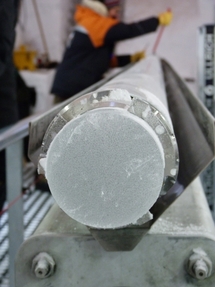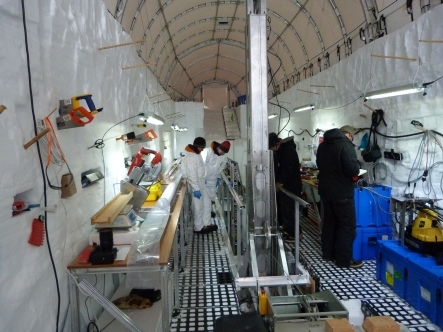by Veronika Meduna

The RICE team, representing eight nations, at the field site on Roosevelt Island (all images courtesy of Nancy Bertler).
Glaciologist Nancy Bertler has spent her last two summers on ice, camped in a tent hundreds of kilometres away from Scott Base, in search of clues about the past behaviour of the Ross Ice Shelf and West Antarctica. Her team set up a drill rig and camp site on a small ice-covered landmass called Roosevelt Island to recover ice cores that contain information about the climate conditions during the last 20,000 years and beyond.
The Roosevelt Island Climate Evolution (RICE) project is an international collaboration between New Zealand, USA, Denmark, UK, Germany, Australia, Italy and China. Its aim is to recover a 750-metre core to determine how quickly the West Antarctic Ice Sheet, the smaller of Antarctica's two icesheets, could change in a warming world. The ANDRILL project, which has analysed sediment cores from two sites at the Ross Ice Shelf, has already shown that about five to three million years ago, the last time when atmospheric concentrations of carbon dioxide and temperatures were similar to those predicted for the end of the 21st century, the Ross Ice Shelf disintegrated several times. The Ross Ice Shelf is a major drainage pathway for the West Antarctic Ice Sheet and any melting of this giant floating slab of ice can initiate the collapse of West Antarctica.
 The advantage of using ice cores (left) is that they provide a much better resolution and can show changes on an annual basis, much like tree rings record growth every year. They also include small bubbles of ancient air, which record the concentration of greenhouse gases at the time.
The advantage of using ice cores (left) is that they provide a much better resolution and can show changes on an annual basis, much like tree rings record growth every year. They also include small bubbles of ancient air, which record the concentration of greenhouse gases at the time.
To determine the rate of change, the RICE project hopes to uncover an annually resolved record for the past 20,000 years and beyond, when global temperatures increased by six degrees Celsius to preindustrial temperatures, global sea level rose by about 120 metres, and the Ross Ice Shelf grounding line retreated over 1000 kilometres.
Between summer field seasons in Antarctica, the RICE cores are being processed at the New Zealand National Ice Core Research Facility at GNS Science.

Under the drill rig, the team had to dig out a temporary and naturally temperature-controlled laboratory in the ice where the cores are processed and stored.

